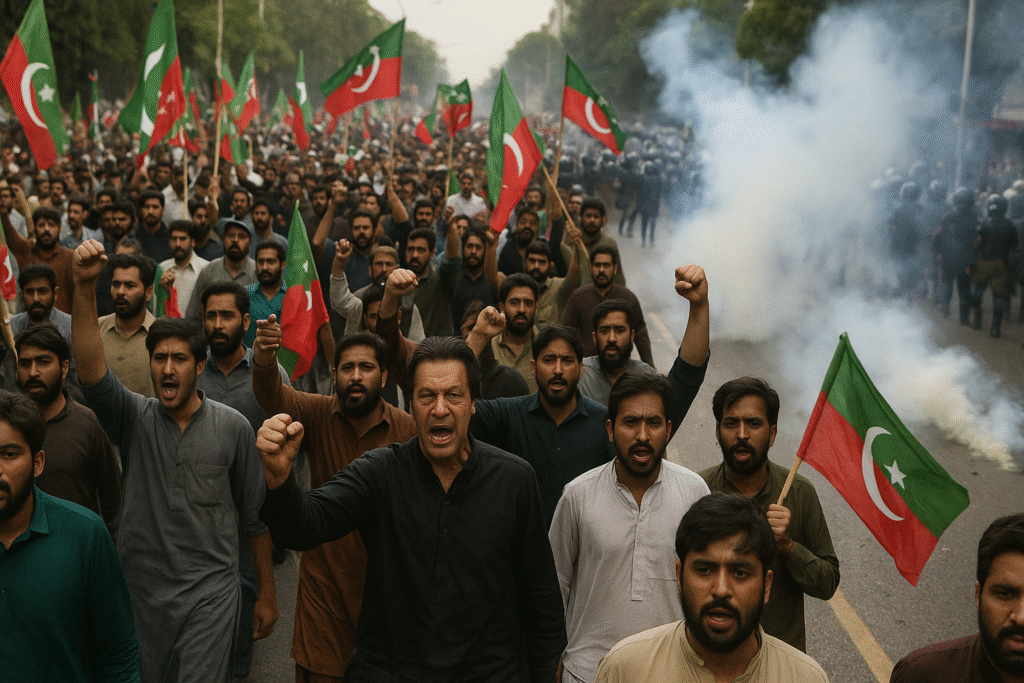
In recent years, Pakistan has seen an unheard-of wave of political unrest, with Pakistan Tehreek-e-Insaf (PTI) leading large protests throughout the country. These performances, ignited by way of the expulsion and later imprisonment of former Prime Minister Imran Khan, continue to form political discourse in Pakistan. As PTI protests for democracy, civil freedom, and the future direction of the nation.
Roots of Protest
Political unrest began in 2022 after the no-confidence vote removed Imran Khan from office.
Allegations of foreign conspiracy, political engineering, and governance intervention trigger a range of rallies by PTI supporters. These rallies were not just an expression of the party’s loyalty – they were a symbol of deep public dissatisfaction with the political and economic trajectory of the country.
By mid-2023, the situation changed when Imran Khan was arrested. There had been violent clashes between the protesters and the law enforcement. In some areas, attackers targeted public homes, police automobiles, and army establishments, which caused many arrests and increased the country’s surveillance.
August 2025: New Protests and Increasing Resistance
On the second anniversary of Khan’s imprisonment in August 2025, PTI released a brand new wave of national protests under the slogan “Free Imran Khan”. Peaceful protesters demanded the discharge of their leaders and truthful elections on the streets in primary towns, such as Lahore, Karachi, Peshawar, and Multan. Despite assurances from the organisers, the government banned public events in fundamental areas, which include Islamabad and Rawalpindi.
In response, law enforcement businesses tore up the protesters, arrested masses of PTI employees, and arrested numerous senior leaders. Clashes between protesters and police forces have come to be commonplace, with tear gas, scenes of baton allegations, and blockades dominating countrywide headlines. However, PTI insisted that their protests would be non-violent and constitutional.
Government’s Reaction
The current administration, supported by powerful military circles, has taken a firm stand against the PTI movement. It accuses the party of creating disturbance and reducing state institutions. In recent months, the courts have sentenced several PTI leaders under allegations of terrorism and treason, first handing over the conditions of long jail terms to those involved in violent protests.
To further control dissatisfaction, the government announced the creation of a new paramilitary force working to handle political opposition. While officers claim that the move aims to shield public safety, critics argue that it’s a tool for suppressing democratic expression.
Additionally, using large-scale arrests, media censorship, and surveillance has raised worries at home and overseas amongst supervisors of human rights and democratic institutions.
Cost of Protest
Beyond political implications, protests have had an important financial and social impact. Cities hosting major demonstrations have reported lakhs of rupees for the loss. Police departments have spent large amounts on crowd control equipment, while blocked roads, internet shutdowns, and fear of violence have disrupted the normal lives of ordinary citizens.
In addition, the families of the arrested protesters have talked about harassment and misuse. Many people complain that others completely target them for their political beliefs, which increases resentment and decreases the trust difference between citizens and the state.
A Divided Nation
There is a deep division in the Pakistani society at the center of this struggle. On the one hand, PTI is pro-PTI, seeing Imran Khan as a symbol of integrity, anti-corruption, and national pride. He believes that a powerful aristocratic class fearing losing control orchestrated his expulsion. On the other hand are those who see PTI’s rhetoric and road power as a threat to law, order, and institutional stability.
This polarization makes dialogue almost impossible. Efforts to negotiate between PTI and the government have failed again and again, and each faction has accused the other of causing the deadlock. Meanwhile, people regularly accuse public establishments, especially the judiciary and the Election Commission, of prejudice, decreasing self-perception in democratic techniques.
Role of the Army
Pakistan’s army plays a major force, a central but controversial role in the country’s politics. While the army denies participation in civil rule, critics argue that the major decision, with a rift in PTI, is in view of its image. Imran Khan’s vocal criticism of the military leadership has only added stress, making reconciliation more difficult.
Some analysts fear that without military neutrality, Pakistan’s democratic visit will remain incomplete. People are worried that the conflict will continue to push the country towards further polarization.
What Lies Ahead?
Further, the future of the PTI protest relies on numerous factors: the birthday celebration’s potential to elevate public aid without triggering violence, the authorities’ desire to allow dissatisfaction, and the position of the judiciary in ensuring justice.
Many believe that the important thing to resolving the crisis lies in obvious elections, fair criminal proceedings, and open dialogues. However, political instability is in all likelihood to stay till these situations are met.
Despite the suppression of the state, PTI continues to gain sympathy, especially among the youth and the urban middle class. Its social media campaigns remain powerful, and the story of resistance to the traditional power games appeals to its tired population.
Conclusion: A Test of Democracy
The ongoing PTI protests in Pakistan mirror not the most effective political competition; however, there is a primary war over democracy, governance, and public opinion. As the movement continues in 2025, it serves as both a challenge and an opportunity for the country. A challenge, because uncontrolled conflict can destabilise institutions. An opportunity, because it forces the country to face its democratic deficiencies.
To proceed to Pakistan, it must establish a balance between order and freedom, ensuring that protests are not criminalised and that the people earn leadership through votes, not through manipulation. Only then can the sounds of millions of March for Change shape a better future.

